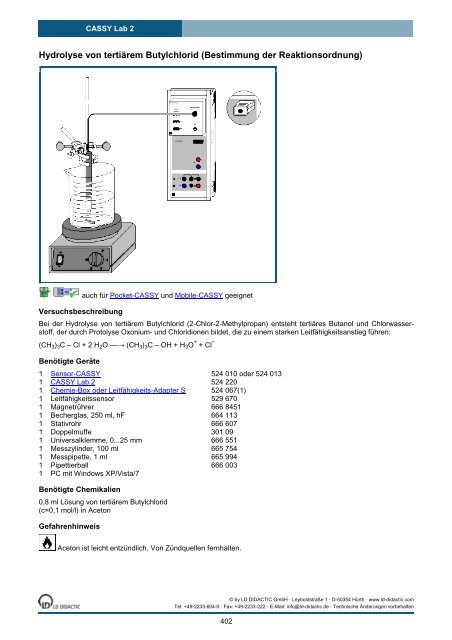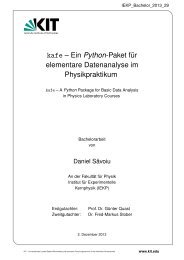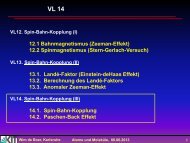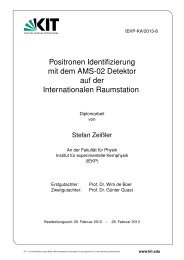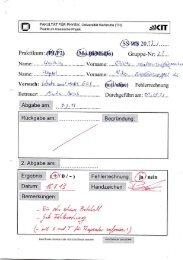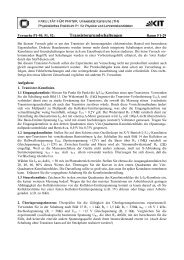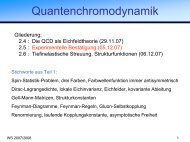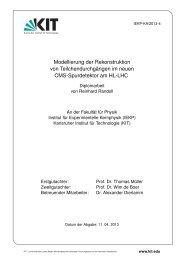- Seite 3 und 4:
CASSY Lab 2 © by LD DIDACTIC GmbH
- Seite 5 und 6:
Inhaltsverzeichnis CASSY Lab 2 Einl
- Seite 7 und 8:
CASSY Lab 2 Auf- und Entladung eine
- Seite 9 und 10:
Einleitung CASSY Lab 2 Dieses Handb
- Seite 11 und 12:
CASSY Lab 2 auf weiteren CASSY-Eing
- Seite 13 und 14:
CASSY Lab 2 instrument des Kanals a
- Seite 15 und 16:
Messung-Menü CASSY Lab 2 Eine Mess
- Seite 17 und 18:
Diagramm-Menü CASSY Lab 2 Die zahl
- Seite 19 und 20:
Diagramm → Markierung setzen →
- Seite 21 und 22:
Dabei sollte immer eine ganze Zahl
- Seite 23 und 24:
Einstellungen und Messparameter Fen
- Seite 25 und 26:
Einstellungen CASSYs CASSY Lab 2 Hi
- Seite 27 und 28:
Einstellungen Analogeingang / Timer
- Seite 29 und 30:
Einstellungen Leistungsfaktor cos
- Seite 31 und 32:
Vielkanal-Messung (VKA) CASSY Lab 2
- Seite 33 und 34:
Einstellungen Funktionsgenerator CA
- Seite 35 und 36:
Einstellungen Rechner CASSY Lab 2 E
- Seite 37 und 38:
CASSY Lab 2 Die wählbare Genauigke
- Seite 39 und 40:
CASSY Lab 2 Neu erstellt eine neue
- Seite 41 und 42:
odd ist 1 wenn Argument ungerade, 0
- Seite 43 und 44:
Formelbeispiele Einfacher Regler:
- Seite 45 und 46:
Sensor-CASSY Einführung Sensor-CAS
- Seite 47 und 48:
Sensor-CASSY 2 Einführung Sensor-C
- Seite 49 und 50:
Power-CASSY Einführung CASSY Lab 2
- Seite 51 und 52:
Profi-CASSY Einführung Profi-CASSY
- Seite 53 und 54:
CASSY-Display Einführung CASSY Lab
- Seite 55 und 56:
Einsatz von Pocket-CASSY CASSY Lab
- Seite 57 und 58:
Einsatz von Mobile-CASSY CASSY Lab
- Seite 59 und 60:
CASSY Lab 2 � Defekte Sicherung n
- Seite 61 und 62:
Technische Daten CASSY Lab 2 1 Anal
- Seite 63 und 64:
Technische Daten CASSY Lab 2 1 Anal
- Seite 65 und 66:
Technische Daten CASSY Lab 2 1 Anal
- Seite 67 und 68:
CASSY Lab 2 Kombi B-Sonde S magneti
- Seite 69 und 70:
Chemie-Box (524 067) pH-Wert pH-Sen
- Seite 71 und 72:
Andere Geräte CASSY Lab 2 CASSY La
- Seite 73 und 74:
Antennendrehtisch CASSY Lab 2 Es wi
- Seite 75 und 76:
SVN (Schülerversuche Naturwissensc
- Seite 77 und 78:
Auswertung � Was wurde im Experim
- Seite 79 und 80:
Auswertung CASSY Lab 2 � Durch di
- Seite 81 und 82:
CASSY Lab 2 � Den Weg s und die L
- Seite 83 und 84:
Versuchsdurchführung CASSY Lab 2 E
- Seite 85 und 86:
Versuchsdurchführung CASSY Lab 2 E
- Seite 87 und 88:
� Versuch mit dem STE-Widerstand
- Seite 89 und 90:
Auswertung CASSY Lab 2 Zur Auswertu
- Seite 91 und 92:
Auswertung CASSY Lab 2 Zur Auswertu
- Seite 93 und 94:
Auswertung CASSY Lab 2 � Welcher
- Seite 95 und 96:
Auswertung CASSY Lab 2 � Welcher
- Seite 97 und 98:
Versuchsaufbau (siehe Abbildung) CA
- Seite 99 und 100:
Temperaturänderung durch Wärmestr
- Seite 101 und 102:
Zusatzaufgabe zur Auswertung CASSY
- Seite 103 und 104:
CASSY Lab 2 � Temperatursensor in
- Seite 105 und 106:
Versuchsaufbau (siehe Abbildung) Hi
- Seite 107 und 108:
CASSY Lab 2 Hinweis: Die Aufheizung
- Seite 109 und 110:
Auswertung � Wodurch unterscheide
- Seite 111 und 112:
• P3.4.5.3 Zeitabhängige Aufzeic
- Seite 113 und 114:
Versuchsdurchführung CASSY Lab 2 E
- Seite 115 und 116:
CASSY Lab 2 Um gute Messergebnisse
- Seite 117 und 118:
CASSY Lab 2 Um eine beschleunigende
- Seite 119 und 120:
CASSY Lab 2 Die kleinen Massestück
- Seite 121 und 122:
Benötigte Geräte 1 Sensor-CASSY 5
- Seite 123 und 124:
Impulserhaltung durch Messung der S
- Seite 125 und 126:
Actio=Reactio durch Messung der Bes
- Seite 127 und 128:
Freier Fall mit g-Leiter auch für
- Seite 129 und 130:
Freier Fall mit g-Leiter (mit Model
- Seite 131 und 132:
Drehbewegungen (Newtonsche Bewegung
- Seite 133 und 134:
Drehimpuls- und Energieerhaltung (D
- Seite 135 und 136:
Zentrifugalkraft (Fliehkraft-Drehar
- Seite 137 und 138:
Zentrifugalkraft (Fliehkraftgerät)
- Seite 139 und 140:
Präzession des Kreisels auch für
- Seite 141 und 142:
Nutation des Kreisels auch für Poc
- Seite 143 und 144:
Schwingungen eines Stabpendels auch
- Seite 145 und 146:
Schwingungen eines Stabpendels (mit
- Seite 147 und 148:
Schwingungen eines Stabpendels (mit
- Seite 149 und 150:
CASSY Lab 2 Abhängigkeit der Schwi
- Seite 151 und 152:
Bestimmung der Erdbeschleunigung mi
- Seite 153 und 154:
Pendel mit veränderbarer Fallbesch
- Seite 155 und 156:
CASSY Lab 2 © by LD DIDACTIC GmbH
- Seite 157 und 158:
Versuchsaufbau (siehe Skizze) CASSY
- Seite 159 und 160:
Versuchsaufbau (siehe Skizze) CASSY
- Seite 161 und 162:
1 Paar Schraubenfedern 352 15 1 Tel
- Seite 163 und 164:
CASSY Lab 2 Schwingungen eines Fede
- Seite 165 und 166:
Einhüllende CASSY Lab 2 Die linear
- Seite 167 und 168:
1 CASSY Lab 2 524 220 1 Laser-Beweg
- Seite 169 und 170:
1 CASSY Lab 2 524 220 1 Laser-Beweg
- Seite 171 und 172:
Benötigte Geräte 1 Sensor-CASSY 5
- Seite 173 und 174:
Gekoppelte Pendel mit zwei Tachogen
- Seite 175 und 176:
Gekoppelte Pendel mit zwei Drehbewe
- Seite 177 und 178:
Dreikörperproblem (mit Modellbildu
- Seite 179 und 180:
� Zweite Stimmgabel anstoßen und
- Seite 181 und 182:
CASSY Lab 2 Die Saite wird zum Schw
- Seite 183 und 184:
1 Hochtonlautsprecher 587 07 1 Univ
- Seite 185 und 186:
CASSY Lab 2 Zusätzlich wird der da
- Seite 187 und 188:
CASSY Lab 2 strecke die Schallgesch
- Seite 189 und 190:
Schallgeschwindigkeit in Festkörpe
- Seite 191 und 192:
Fourier-Analyse von simulierten Sig
- Seite 193 und 194:
Fourier-Analyse von Signalen eines
- Seite 195 und 196:
Tonanalyse auch für Pocket-CASSY g
- Seite 197 und 198:
Tonsynthese Versuchsbeschreibung CA
- Seite 199 und 200:
1 Verbindungskabel, 6-polig, 1,5 m
- Seite 201 und 202:
Umwandlung von elektrischer Energie
- Seite 203 und 204:
CASSY Lab 2 halb der Heizspirale be
- Seite 205 und 206:
Versuchsbeschreibung CASSY Lab 2 Th
- Seite 207 und 208:
Coulombsches Gesetz auch für Pocke
- Seite 209 und 210:
CASSY Lab 2 � Kraftnullpunkt eins
- Seite 211 und 212:
zw. der Betrag der Kraft durch F =
- Seite 213 und 214:
Kraft im magnetischen Feld eines El
- Seite 215 und 216:
Kraft zwischen stromdurchflossenen
- Seite 217 und 218:
µ0/2π = F/I 2 ·r / s = F/I 2 ·r
- Seite 219 und 220:
Versuchsdurchführung a) Messung in
- Seite 221 und 222:
Induktion durch ein veränderliches
- Seite 223 und 224:
Versuchsaufbau (siehe Skizze) CASSY
- Seite 225 und 226:
CASSY Lab 2 Zeitabhängige Aufzeich
- Seite 227 und 228:
Leistungsübertragung eines Transfo
- Seite 229 und 230:
CASSY Lab 2 Leistung beliebiger mit
- Seite 231 und 232:
Auf- und Entladung eines Kondensato
- Seite 233 und 234:
Auf- und Entladung eines Kondensato
- Seite 235 und 236:
Auf- und Entladung eines kleinen Ko
- Seite 237 und 238:
Gedämpfter Schwingkreis Versuchsbe
- Seite 239 und 240:
Gedämpfter Schwingkreis (mit Model
- Seite 241 und 242:
Gekoppelte Schwingkreise Versuchsbe
- Seite 243 und 244:
Erzwungene Schwingungen (Resonanz)
- Seite 245 und 246:
Erzwungene Schwingungen (mit Modell
- Seite 247 und 248:
RLC-Filter (Tiefpass, Hochpass, Ban
- Seite 249 und 250:
Tiefpass-Filter (mit Modellbildung)
- Seite 251 und 252:
CASSY Lab 2 Außerdem ist eine Anpa
- Seite 253 und 254:
1 STE Widerstand 20 Ω 577 23 1 STE
- Seite 255 und 256:
Kennlinie einer Glühlampe Versuchs
- Seite 257 und 258:
1 STE-Leuchtdiode infrarot 578 49 1
- Seite 259 und 260:
) Kennlinie Kollektorstrom IC gegen
- Seite 261 und 262:
Versuchsdurchführung Einstellungen
- Seite 263 und 264:
Versuchsaufbau (siehe Skizze) CASSY
- Seite 265 und 266:
Versuchsdurchführung CASSY Lab 2 E
- Seite 267 und 268:
Versuchsaufbau (siehe Skizze) CASSY
- Seite 269 und 270:
mit Wegaufnehmer und 529 031 Paar K
- Seite 271 und 272:
Beugung an Mehrfachspalten auch fü
- Seite 273 und 274:
CASSY Lab 2 � Messung mit starten
- Seite 275 und 276:
CASSY Lab 2 � Abstand in Tabelle
- Seite 277 und 278:
Auswertung CASSY Lab 2 Der optische
- Seite 279 und 280:
Versuchsdurchführung CASSY Lab 2 E
- Seite 281 und 282:
Es gilt also: 0 = F+F1 = -4/3 π·r
- Seite 283 und 284:
Franck-Hertz-Versuch mit Quecksilbe
- Seite 285 und 286:
2) Optimierung von U1 Eine höhere
- Seite 287 und 288:
CASSY Lab 2 Dazu befindet sich Neon
- Seite 289 und 290:
Moseleysches Gesetz (K-Linien-Rönt
- Seite 291 und 292:
Auswertung CASSY Lab 2 Mit höherer
- Seite 293 und 294:
CASSY Lab 2 Die Bezeichnungen der c
- Seite 295 und 296:
CASSY Lab 2 Energieaufgelöste Brag
- Seite 297 und 298:
Energiekalibrierung CASSY Lab 2 Die
- Seite 299 und 300:
CASSY Lab 2 Compton berechnete nun
- Seite 301 und 302:
CASSY Lab 2 einen Wert für den Par
- Seite 303 und 304:
Auswertung CASSY Lab 2 Zur Auswertu
- Seite 305 und 306:
Versuchsaufbau (siehe Skizze) CASSY
- Seite 307 und 308:
1 Alpha-Spektroskopiekammer 559 565
- Seite 309 und 310:
Versuchsbeschreibung CASSY Lab 2 De
- Seite 311 und 312:
Versuchsbeschreibung CASSY Lab 2 De
- Seite 313 und 314:
CASSY Lab 2 Bestimmung des Energiev
- Seite 315 und 316:
Altersbestimmung an einer Ra-226 Pr
- Seite 317 und 318:
Nachweis von γ-Strahlung mit einem
- Seite 319 und 320:
Aufnahme und Kalibrierung eines γ-
- Seite 321 und 322:
Absorption von γ-Strahlung auch f
- Seite 323 und 324:
CASSY Lab 2 Identifizierung und Akt
- Seite 325 und 326:
Aufnahme eines β-Spektrums mit ein
- Seite 327 und 328:
Quantitative Beobachtung des Compto
- Seite 329 und 330:
CASSY Lab 2 Aufnahme des komplexen
- Seite 331 und 332:
Koinzidenz und γ-γ-Winkelkorrelat
- Seite 333 und 334:
CASSY Lab 2 Um die Unterdrückung z
- Seite 335 und 336:
2 VKA-Boxen 524 058 1 Co-60 Präpar
- Seite 337 und 338:
1 Sockel 300 11 1 Paar Kabel, 50 cm
- Seite 339 und 340:
2 Kabel, 100 cm, schwarz 500 444 1
- Seite 341 und 342:
Versuchsbeschreibung In einem Trans
- Seite 343 und 344:
CASSY Lab 2 Zerstörungsfreie Analy
- Seite 345 und 346:
CASSY Lab 2 � Im Kontextmenü des
- Seite 347 und 348:
CASSY Lab 2 Zum Ausrechnen der Mass
- Seite 349 und 350:
Versuchsbeispiele Chemie CASSY Lab
- Seite 351 und 352: Streichhölzer oder Feuerzeug 1 PC
- Seite 353 und 354: Lebensmittel/Getränke, z.B.: Miner
- Seite 355 und 356: pH-Messung an Reinigungsmitteln Ver
- Seite 357 und 358: CASSY Lab 2 Da basische Seifenlösu
- Seite 359 und 360: CASSY Lab 2 Nach der Bestimmung von
- Seite 361 und 362: Titration von Phosphorsäure Gefahr
- Seite 363 und 364: Versuchsdurchführung CASSY Lab 2 E
- Seite 365 und 366: Benötigte Chemikalien 1 Palmitins
- Seite 367 und 368: 2 Universalklemmen, 0...25 mm 666 5
- Seite 369 und 370: Molmassenbestimmung durch Gefrierpu
- Seite 371 und 372: CASSY Lab 2 � Zur Herstellung der
- Seite 373 und 374: Titration von Salzsäure mit Natron
- Seite 375 und 376: Weitere Versuchsmöglichkeiten CASS
- Seite 377 und 378: 1 Stativstab, 450 mm, Gewinde M10 6
- Seite 379 und 380: Titration von Essigsäure mit Natro
- Seite 381 und 382: Auswertung CASSY Lab 2 Die Ermittlu
- Seite 383 und 384: NaH2PO4 * 2 H2O z.B. 50 g: 673 6000
- Seite 385 und 386: Automatische Titration (Tropfenzäh
- Seite 387 und 388: CASSY Lab 2 Mit Hilfe der mitgelief
- Seite 389 und 390: Versuchsaufbau (siehe Skizze) CASSY
- Seite 391 und 392: Versuchsaufbau (siehe Skizze) CASSY
- Seite 393 und 394: CASSY Lab 2 � Um ein positives Si
- Seite 395 und 396: CASSY Lab 2 � Je eine Rundküvett
- Seite 397 und 398: CASSY Lab 2 � In einem Punkt müs
- Seite 399 und 400: 1 Messkolben, 100 ml 665 793 1 Uhrg
- Seite 401: Die Reaktionsgeschwindigkeit der Ha
- Seite 405 und 406: CASSY Lab 2 Reaktion von Marmor mit
- Seite 407 und 408: Theoretischer Hintergrund CASSY Lab
- Seite 409 und 410: 1 Chemie-Box oder Leitfähigkeits-A
- Seite 411 und 412: CASSY Lab 2 Eine Auftragung von ln[
- Seite 413 und 414: CASSY Lab 2 Aktivierungsenthalpie
- Seite 415 und 416: k = a · e -b/T CASSY Lab 2 als Fre
- Seite 417 und 418: CASSY Lab 2 Im Beispiel werden die
- Seite 419 und 420: Herstellung einer Kältemischung Ve
- Seite 421 und 422: Bestimmung der Schmelzenthalpie von
- Seite 423 und 424: CASSY Lab 2 Mit dem Wasserwert m0 =
- Seite 425 und 426: Benötigte Chemikalien D(+)-Glucose
- Seite 427 und 428: Bestimmung der Grenzleitfähigkeit
- Seite 429 und 430: Versuchsdurchführung Einstellungen
- Seite 431 und 432: 1 PC mit Windows XP/Vista/7 Benöti
- Seite 433 und 434: CASSY Lab 2 in die Gleichung für K
- Seite 435 und 436: Versuchsaufbau (siehe Skizze) CASSY
- Seite 437 und 438: Versuchsdurchführung CASSY Lab 2 E
- Seite 439 und 440: CASSY Lab 2 Das UV-IR-VIS-Experimen
- Seite 441 und 442: Treibhauswirkung von CO2 Sicherheit
- Seite 443 und 444: CASSY Lab 2 voreingestellt. Die Ein
- Seite 445 und 446: Puls auch für Pocket-CASSY geeigne
- Seite 447 und 448: CASSY Lab 2 Die durchschnittliche H
- Seite 449 und 450: Benötigte Geräte 1 Sensor-CASSY 5
- Seite 451 und 452: Blutdruck auch für Pocket-CASSY ge
- Seite 453 und 454:
Reaktionszeit auch für Pocket-CASS
- Seite 455 und 456:
Lungenvolumen (Spirometrie) auch f
- Seite 457 und 458:
Langzeitmessung von Klimadaten Vers
- Seite 459 und 460:
Versuchsbeispiele Technik CASSY Lab
- Seite 461 und 462:
CASSY Lab 2 Das Primäroszillogramm
- Seite 463 und 464:
Kfz - Gemischaufbereitungssysteme S
- Seite 465 und 466:
CASSY Lab 2 Der Anteil der Unterdru
- Seite 467 und 468:
Kfz - Bordcomputer mit Radio Versuc
- Seite 469 und 470:
Kfz - Komfortsystem mit CAN-Bus Ver
- Seite 471 und 472:
Kfz - Untersuchung von CAN-Datenbus
- Seite 473 und 474:
Puls-Code-Modulation (Quantisierung
- Seite 475 und 476:
CASSY Lab 2 Physikalische Grundlage
- Seite 477 und 478:
Zweiplattenleitung (TEM- und TE-Mod
- Seite 479 und 480:
Auswertung Wellenlänge Mit der fre
- Seite 481 und 482:
2 Stützen für Hohlleiterkomponent
- Seite 483 und 484:
Antennentechnik Sicherheitshinweise
- Seite 485 und 486:
CASSY Lab 2 wobei Umax die maximal
- Seite 487 und 488:
Kopierformel A*abs(cos(x))*abs(cos(
- Seite 489 und 490:
Versuchsaufbau CASSY Lab 2 Bauen Si
- Seite 491 und 492:
Halbleiterzähler CASSY Lab 2 Zum N
- Seite 493 und 494:
Compton-Effekt (Grundlagen) Histori
- Seite 495 und 496:
Abgedeckte Präparate CASSY Lab 2 D
- Seite 497 und 498:
Die Daten entstammen: The Lund/LBNL
- Seite 499 und 500:
Natrium-22 CASSY Lab 2 Natrium-22 i
- Seite 501 und 502:
Americium-241 CASSY Lab 2 Americium
- Seite 503 und 504:
CASSY Lab 2 len elektrischen Impuls
- Seite 505 und 506:
84-Po-218 Polonium-218 (Po-218 wird
- Seite 507 und 508:
Thorium-232 CASSY Lab 2 Thorium ist
- Seite 509 und 510:
Die Energien der emittierten Elektr
- Seite 511 und 512:
Zerfallskaskaden CASSY Lab 2 Der Ze
- Seite 513 und 514:
Filter 247, 249, 252 Fliehkraft 135
- Seite 515:
Sensoren 27, 66 Servotechnik 488 si


